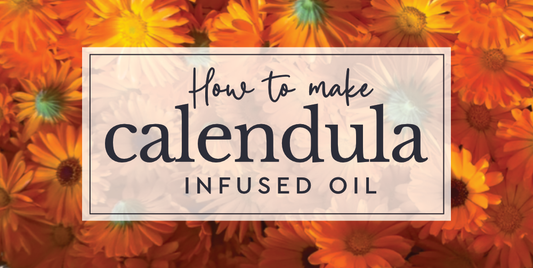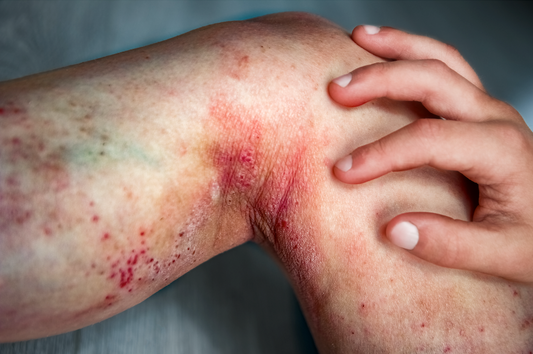Calendula oil is one of nature’s most soothing remedies for irritated, dry, and eczema-prone skin. This simple DIY infusion captures the healing power of calendula flowers and transforms them into a versatile oil you can use for moisturising, calming flare-ups, or blending into balms and creams.
In this guide, you’ll learn how to make calendula infused oil at home, discover its powerful skin benefits, and explore different ways you can use it for natural healing.


What Is Calendula?
Calendula (Calendula officinalis), often called pot marigold, is a bright golden flower belonging to the daisy family. For centuries, it has been prized in herbal medicine and skincare thanks to its wide range of healing properties.
Calendula is rich in flavonoids, carotenoids, and antioxidants, which give it anti-inflammatory, antibacterial, and wound-healing abilities. Traditionally, it has been used to:
- Support wound healing
- Reduce inflammation and redness
- Calm rashes and minor burns
- Hydrate and nourish dry, delicate skin
It’s also edible and often used in teas, cooking, and even as a natural dye.


Calendula Skin Benefits
Calendula is widely recognised for its skin-soothing and protective properties, making it ideal for those with eczema, psoriasis, and dry or sensitive skin.
Key Benefits of Calendula for Skin:
- Soothes eczema and dermatitis – helps calm irritation, itching, and inflammation.
- Hydrates dry skin – provides lasting moisture without clogging pores.
- Supports skin barrier repair – strengthens delicate, damaged skin.
- Gentle enough for babies – often used in natural remedies for diaper rash.
-
Antioxidant protection – defends against free radical damage that can worsen sensitivity.


How to Make Calendula Infused Oil (DIY Guide)
Making your own calendula infused oil is simple and cost-effective. You’ll need dried calendula flowers and a carrier oil such as olive, sunflower, almond, grapeseed or jojoba.
Step 1: Dry the Flowers
Harvest the flowers on a dry, sunny day for maximum potency. Lay them out in a single layer and let them air dry for 1-2 weeks until they’re crisp and papery. This prevents moisture from spoiling the oil. No homegrown flowers? No problem! High-quality dried calendula is readily available online or at herbal shops.


Step 2: Choose a Carrier Oil
Olive oil is nourishing, while jojoba is closer to skin’s natural sebum. Choose the oil best suited for your skin needs.
Step 3: Infuse the Oil
Once your calendula flowers are dried and your carrier oil is ready, you can infuse them using two simple methods:
a. Solar Infusion (Traditional method & my personal favourite)
- Place the dried petals (about 2/3 full) in a clean jar and cover with oil.
- Seal and leave on a sunny windowsill for 4–6 weeks, shaking gently every few days.
- The longer it sits, the richer and more potent the oil becomes!
b. Heat Infusion (Faster method)
- Place petals and oil in a jar and set in a warm water bath or double boiler on very low heat (≈38°C / 100°F) for 4–6 hours.
- Stir occasionally and keep the heat gentle to protect the skin-loving compounds.


Step 4: Strain & Store
Once infused, strain out the petals using cheesecloth or a fine sieve. Store the oil in a dark glass bottle, labelled with the date. Shelf life is around 6–12 months when stored in a cool, dark place.
How to Use Calendula Oil
Calendula oil is a multitasking remedy that can be used on its own or incorporated into other natural skincare recipes.
Daily Moisturiser for Dry & Eczema-Prone Skin
Apply directly to dry patches, eczema flare-ups, or irritated areas for soothing hydration.
Healing Balm & After-Sun Care
Blend with beeswax to create a balm for minor cuts, burns, or sun-exposed skin.
Baby Care
Calendula oil is gentle enough for babies—use it for dry patches or cradle cap.
Scalp & Hair Treatment
Massage into the scalp to ease dryness or add shine and nourishment to hair.
Nail & Cuticle Oil
Apply to nails and cuticles to strengthen and prevent dryness.


Calendula Oil for Eczema and Dry Skin
If you suffer from eczema or persistently dry skin, calendula oil can be a game-changer. Its anti-inflammatory properties calm itchiness and redness, while its deep hydration helps repair the skin barrier.
Although it shouldn’t replace prescribed treatments for severe eczema, many people find it a valuable part of their natural skincare routine. Always patch-test first and consult a healthcare professional if you have concerns.
FAQs About Calendula Oil
How long does homemade calendula oil last?
Around 6–12 months when stored in a cool, dark place.
Can calendula oil be used on babies?
Yes, but always patch-test first and consult your doctor if your child has eczema or very sensitive skin.
Can calendula oil replace my moisturiser?
It can be used alone, but for extra nourishment, you can mix it into creams or balms.

Try Our Calendula Cream for Eczema and Dry Skin
Looking for a natural calendula cream for eczema and dry skin?
Our bestselling Calendula Soothe & Repair Cream is made with calendula oil I handcraft from flowers I grow myself in Cornwall. Packed with soothing botanicals, it helps calm irritation, ease itching, and deeply moisturise sensitive, eczema-prone skin.





